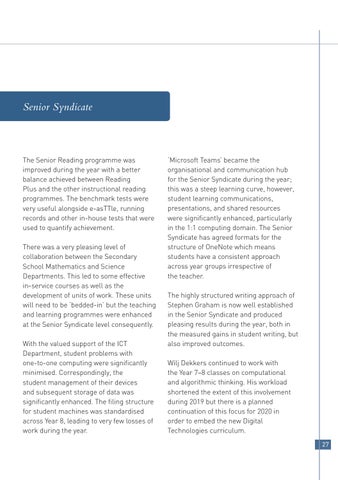Senior Syndicate
The Senior Reading programme was improved during the year with a better balance achieved between Reading Plus and the other instructional reading programmes. The benchmark tests were very useful alongside e-asTTle, running records and other in-house tests that were used to quantify achievement. There was a very pleasing level of collaboration between the Secondary School Mathematics and Science Departments. This led to some effective in-service courses as well as the development of units of work. These units will need to be ‘bedded-in’ but the teaching and learning programmes were enhanced at the Senior Syndicate level consequently. With the valued support of the ICT Department, student problems with one-to-one computing were significantly minimised. Correspondingly, the student management of their devices and subsequent storage of data was significantly enhanced. The filing structure for student machines was standardised across Year 8, leading to very few losses of work during the year.
‘Microsoft Teams’ became the organisational and communication hub for the Senior Syndicate during the year; this was a steep learning curve, however, student learning communications, presentations, and shared resources were significantly enhanced, particularly in the 1:1 computing domain. The Senior Syndicate has agreed formats for the structure of OneNote which means students have a consistent approach across year groups irrespective of the teacher. The highly structured writing approach of Stephen Graham is now well established in the Senior Syndicate and produced pleasing results during the year, both in the measured gains in student writing, but also improved outcomes. Wilj Dekkers continued to work with the Year 7–8 classes on computational and algorithmic thinking. His workload shortened the extent of this involvement during 2019 but there is a planned continuation of this focus for 2020 in order to embed the new Digital Technologies curriculum. 27












